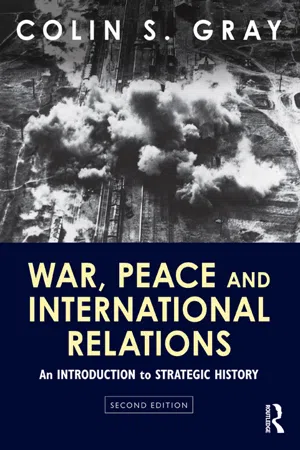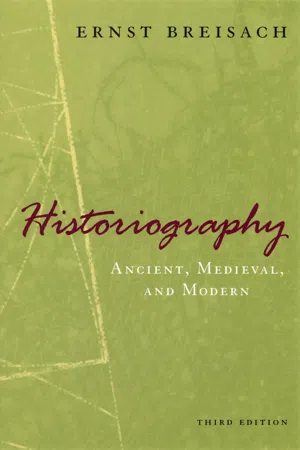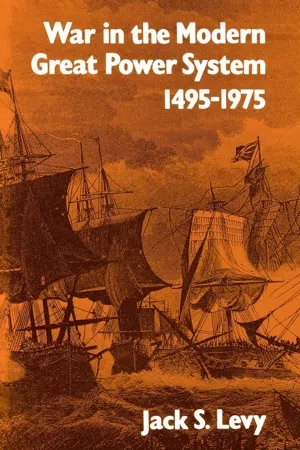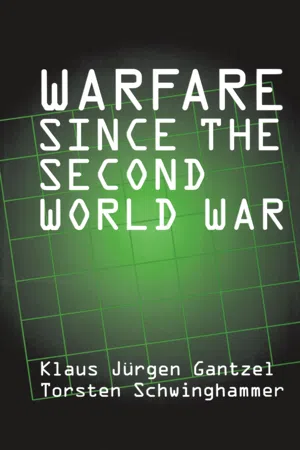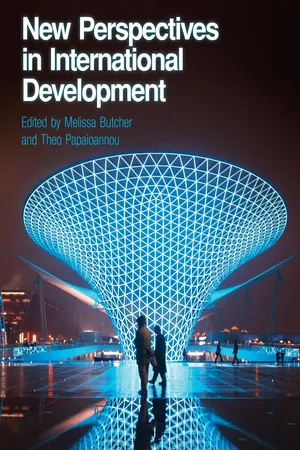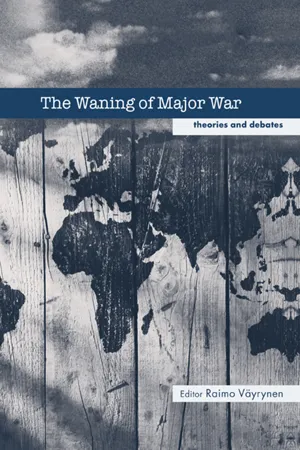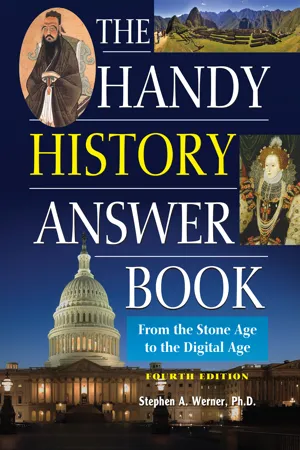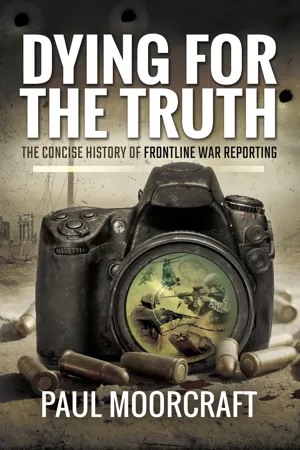History
World Wars
The World Wars refer to two major global conflicts primarily fought in the 20th century. World War I (1914-1918) involved many of the world's great powers and was triggered by the assassination of Archduke Franz Ferdinand of Austria. World War II (1939-1945) was even more widespread and devastating, involving many countries and resulting in significant geopolitical and social changes.
Written by Perlego with AI-assistance
Related key terms
9 Key excerpts on "World Wars"
- eBook - ePub
War, Peace and International Relations
An introduction to strategic history
- Colin S. Gray(Author)
- 2013(Publication Date)
- Routledge(Publisher)
6 World War I, I
ControversiesReader's guide: Controversies about World War I. The scale of the conflict. Casualties.Introduction: the making of the twentieth century
With black humour, one could argue that the Great War of 1914–18 was the kind of conflict that gives war a bad name. War should be an instrument of policy; Clausewitz is crystal clear on that fundamental. However, once the basic decisions to fight were taken, for four and a quarter years warfare seemed more in command of the policies of states than commanded by them. That was not quite true, but nor was it wholly an illusion. The strategic historian takes serious note of Gary Sheffield's expansive claim that ‘The First World War was the key event of the twentieth century, from which everything else flowed’ (Sheffield, 2001: 221). Sheffield is persuasive, provided one does not take too literally his assertion that ‘everything else flowed’ from the war. One has to beware of such a vague concept as the flow of events – sometimes events seem to trickle lazily, at other times they appear to rest, while they have also been known to reverse direction as in ‘a turning tide’. While there is no doubt that in many vital respects the Great War made the twentieth century, certainly politically and strategically, there is good reason to question the responsibility of the war for all that followed over the next eighty years.It is plausible to claim that the Great War against France which concluded in 1815 had reshaped, even redefined, international politics for at least a half-century. Similarly, it is scarcely less persuasive to argue that Bismarck's wars to unite Germany under Prussian tutelage and for Prussia's benefit reconstructed the architecture of the balance of power. The German Chancellor decisively altered the way that international politics would have to be managed by the great powers. Now the temporal domain of the strategic historical argument needs to be extended. The war of 1914–18 was uniquely responsible for setting the stage for, and thereby enabling, the major political and strategic events of the century that followed, but even the most influential of historical episodes, which tend to be strategic in character, do not drive forward along predetermined linear paths. Two fallacies beg for attention. - eBook - ePub
Historiography
Ancient, Medieval, and Modern, Third Edition
- Ernst Breisach(Author)
- 2008(Publication Date)
- University of Chicago Press(Publisher)
22Historiography between Two World Wars(1918—39)
The Twentieth-Century ContextWhen in 1914 soldiers marched among masses of jubilant onlookers on their way to the battles of the First World War, many of them were aware that they might die, but not that a whole way of life would be buried with them. The marchers led the world into decades of monumental changes in how life was led and thought about. Many of the developments, already underway in Western culture since the late nineteenth century, were vastly energized and accelerated after 1918: advances in the sciences and technology, making the masses benefactors of the production of goods and means of communication; the political, social, and economic emancipation of so far neglected groups; and the progress of globalization. Prior to 1914, many people had viewed these developments, visible in their early impact, as validation of an optimistic, strongly progressive assessment of the future. Expectations had been high for an unbroken amelioration of the human condition.But events in the twentieth century showed the ambivalence of these seemingly beneficial processes. First, science and technology’s increasing understanding of and control over natural forces led to substantial improvements in human life, but also would provide the tools for new types of warfare, genocides, and weapons of mass destruction.Second, the masses did become the benefactors when the ideal of equality was approximated to a higher degree in the situation of women, minorities, and other marginalized groups. But this humanitarian development was counterbalanced by the misuse of mass movements for experiments in building new societies that ruthlessly enforced limited visions on what the human being should be. The results were dictatorships of previously unthinkable brutality. In liberal democratic societies the excesses of mass consumption, mass media, and mass production made their own far less destructive but still negative impact on human life and nature. - eBook - ePub
War in the Modern Great Power System
1495–1975
- Jack S. Levy(Author)
- 2021(Publication Date)
- The University Press of Kentucky(Publisher)
In addition, the inclusion of the Clausewitzian concept of the pursuit of national policy, unless defined very broadly, would exclude conflicts initiated primarily for domestic political or even personal reasons. War must be defined independently of its motivations or other causes (or consequences), for otherwise hypotheses regarding the causes or consequences of war would be reduced to tautologies and made untestable. Therefore, this study defines war as a substantial armed conflict between the organized military forces of independent political units. 3 Using this final definition, one criterion for the classification of wars is the nature of the participating actors. The Great Powers constitute a distinctive set of states in the international system; therefore, a distinct set of wars involving the Great Powers can be defined and identified. These wars are a subset of a larger set of interstate wars between sovereign states in the international system. For reasons suggested earlier, the focus in this study is on interstate wars involving the Great Powers. Excluded from this study are the following: (1) any war that does not involve a Great Power (as identified in Chapter 2); (2) civil wars, unless they become internationalized through the intervention of an external state; and (3) imperial or colonial wars, unless they expand through the intervention of another state. Operational criteria to differentiate civil wars and imperial or colonial wars from others will be provided in a later section. An important subset of the interstate wars involving the Great Powers consists of wars with at least one Great Power on each side of the conflict. These wars, labeled Great Power wars, generally involve a greater level of violence and have a greater impact on the international system than do wars involving only one Power. Throughout this study I will differentiate between wars involving the Great Powers and Great Power wars - eBook - ePub
- Torsten Schwinghammer(Author)
- 2018(Publication Date)
- Routledge(Publisher)
2Definitions and Inclusion Criteria for the List of Wars Since the Second World War This chapter defines war and sets out the inclusion criteria upon which we base our list of wars from the end of the Second World War through 1992.Although the first of these wars—the first Greek Civil War—began on December 3,1944, and thus technically predates 1945, it nonetheless belongs to the new epoch emerging out of the Second World War and accordingly shares its symbolic significance. In order to avoid statistical bias and to maintain the symbolic caesura of “1945” we portray the first Greek Civil War unless otherwise noted as beginning in January of 1945 and extend it Actively 29 days after its actual end on February 12, 1945.2.1 Definition of “War”
Following István Kende (1982a:5f) we regard any violent mass conflict which includes all the following characteristics as war:- Two or more armed forces take part in the fighting and at least one side is composed of regular government troops (military, paramilitary groups, armed police units).
- A minimum of centrally directed organization of both warring parties must be present, if only as organized armed defense or strategic/tactical attacks (guerrilla operations, partisan war, etc.).
- The armed operations must have continuity and not be only occasional, spontaneous clashes. This means both sides must follow a planned strategy whether the fighting takes place on the territory of one or several societies and regardless of the length of the conflict.
In contrast to Small and Singer (1982), among others, our definition does not initially differentiate between international and intranational wars.1 - eBook - ePub
- Melissa Butcher, Theo Papaioannou(Authors)
- 2013(Publication Date)
- Bloomsbury Academic(Publisher)
That is, war is seen as an instrument of political action, used by the leaders of states to attain identified goals, whether that be taking territory (as with the Iraqi invasion of Kuwait), reducing an enemy’s military power, or some other specific strategic, political, economic or cultural goal. For Mann, war in this phase was limited in goals – what war aimed to achieve – and in the means used – the size of armies or weapons technology used. It was also limited in terms of the extent to which society as a whole was involved in warfare. Limited wars often drew on a small proportion of the population to do the fighting, while declaring war, formulating strategy and concluding peace deals were mainly decided by aristocratic and political elites. Wars of this kind were also typically of short duration. Many of these wars involved territorial expansion in the context of colonialism, such as the Boer War (1899–1902). As you will see in Subsection 2.2.2, even in this phase, for some historians, warfare had a very major developmental impact on the European states involved. Mann suggests the second phase of warfare is total war, exemplified by the period of the two World Wars (1914–18 and 1939–45). Total war was unlimited in its goals – the aim was the complete destruction of the opponent. It utilized increasingly destructive and mobile forms of technology through the ‘industrialization’ of warfare, and the constant revolutionizing of the means of war through the application of industrial science and technology. In these wars, the whole manufacturing sector of respective states often became devoted to weapons production or forms of military support, such as medical supplies, aeronautics and communication. As a result, total war also drew in ever greater numbers of people, eventually seeking the total mobilization of societies through mass conscription and the diversion of economic output to achieve war ends, as was the case, in particular, in World War II - eBook - ePub
- John Mueller(Author)
- 2013(Publication Date)
- Cornell University Press(Publisher)
9 Yet beliefs and experiences like this had never brought about a widespread desire to abandon war as an institution. Instead war continued to be accepted as a normal way of doing things.Nor was World War I special in the economic devastation it caused. Many earlier European wars had been fought to the point of total economic exhaustion. Richard Kaeuper’s analysis of the economic effects of decades of war in the late Middle Ages catalogs the destruction of property, the collapse of banks, the severing of trade and normal commerce, the depopulation of entire areas, the loss of cultivated land, the decline of production, the reduction of incomes, the disruption of coinage and credit, the hoarding of gold, and the assessment (with attendant corruption) of confiscatory war taxes. The Thirty Years War set back the Germany economy by decades, and the Seven Years War brought Austria to virtual bankruptcy, whereas many primitive wars have essentially destroyed whole societies. By contrast, within a few years after the First World War, most of the combating nations had substantially recovered economically: by 1929 the German economy was fully back to prewar levels, while the French economy had surpassed prewar levels by 38 percent.10World War I toppled several political regimes—in Germany, Russia, and Austria-Hungary—but it was hardly unusual in this respect. And to suggest that World War I was new in the annals of warfare in its tragic futility and political pointlessness would be absurd; by most reasonable standards, huge numbers of previous wars would rival, and often surpass, it on those dimensions.In some respects World War I could be seen to be an improvement over many earlier wars. Civilian loss, in the West at least, was proportionately quite low, whereas earlier wars had often witnessed the annihilation of entire cities.11 - eBook - ePub
The Waning of Major War
Theories and Debates
- Raimo Vayrynen(Author)
- 2013(Publication Date)
- Routledge(Publisher)
The world seems, then, to have continued, even accelerated, its retreat from doomsday – a word that has, in fact, picked up a slight aura of quaintness over the last decade and half. And, however imprudently, many air raid shelters do seem to have been allowed to lapse into disrepair.Not only did developed countries manage to stay out of war with each other during the Cold War, but there have been remarkably few international wars of any sort since World War II. The only truly notable exception since 1975 (and it is an important one) was the bloody war between Iran and Iraq that lasted from 1980 to 1988. Moreover, it is probably significant that, although armed contests between the Israeli government and Palestinian rebels remained plentiful, no Arab or Muslim country was willing after 1973 to escalate the contest to international war by sending its troops to participate directly. Also in decline, it appears, are conventional civil war, colonial war, and ideological civil war.Changing attitudes toward warThis remarkable phenomenon chiefly stems, it seems to me, from the way attitudes toward the value and efficacy of war have changed, particularly over the last century, and the key to the development lies in the machinations of idea entrepreneurs. A profound disillusionment with war took place in Europe at the time of World War I. This came about not because that war was peculiarly destructive and costly, but because of the success of the idea entrepreneurs of the prewar antiwar movement in presenting their once-novel argument that war – by which they primarily meant war among developed states – ought to be abolished.4 World War II in Europe was almost single handedly created by one man, Adolf Hitler: historical conditions in no important way required another continental war in Europe, and the major nations there were not on a collision course. The Cold War, in my view, was primarily caused by Communist devotion to an ideology about violent revolution and international class warfare that seemed threateningly expansionary to the democratic, capitalist West. However, despite the severe ideological dispute between the Communist and the non-Communist world and despite a surrogate war in Korea that permanently seems to have discredited limited military probes as a revolution-enhancing technique, major war was never really on the cards.5 - eBook - ePub
The Handy History Answer Book
From the Stone Age to the Digital Age
- Stephen A. Werner(Author)
- 2020(Publication Date)
- Visible Ink Press(Publisher)
THE World Wars WORLD WAR I What was World War I called before there was a World War II?The war from 1914 to 1918 was called the “Great War.” It was the largest war up to that point in history. Many hoped it would be the last such war. It wasn’t. When the Germans invaded Poland in 1939, another war began. The Great War became World War I, and the new war became World War II.The Great War would also be the largest human undertaking in history—up to that point—yet none of the countries involved wanted a world war that would last four years, and almost none of the political leaders saw it coming, yet they stumbled into it. Here is how that happened.How did World War I begin?The Great War was sparked by the June 28, 1914, assassination of Archduke Franz Ferdinand of Austria-Hungary (1863–1914). However, the war in Europe had been precipitated by several developments. National pride had been growing among Europeans; nations increased their armed forces through drafts; and colonialism continued to be a focus of the European powers as they competed for control of lands in far-off places. At the same time, weapons and other implements of war had been improved by industry and science, making them deadlier than ever.On that June day in the city of Sarajevo (then the capital of Austria-Hungary’s province of Bosnia and Herzegovina), when a gunman named Gavrilo Princip (1894–1918) shot down Archduke Franz Ferdinand and his wife, it was not surprising that Austria-Hungary responded with force. Princip was known to have ties to a Serbian terrorist organization, the Black Hand, that was connected to military officers in the Kingdom of Serbia. Although the assassination took place within their territory, Austria-Hungary blamed the nearby country of Serbia. Austria-Hungary feared that the Greater Serbian movement might grow and wreck their empire. - eBook - ePub
Dying for the Truth
The Concise History of Frontline War Reporting
- Paul Moorcraft(Author)
- 2016(Publication Date)
- Pen & Sword Military(Publisher)
Her Privates We , an often overlooked masterpiece also published in 1929, fatalistically presented the conflict as a horrible but unavoidable part of the human condition. Few held on to the belief that the 1914–18 war was the war to end all wars. Hitler confirmed their fears. Since then, historic fashion has venerated writers who have condemned the First World War but at the same time condemned those who embraced appeasement, the logical corollary. Anti-war literature and appeasement both derived their appeal from the same basic liberalism that inspired the peacemakers’ ideals, especially those of the Americans, at Versailles in 1919. Liberalism failed in the interwar years – failed to enforce its own standards, especially via the new League of Nations – because that determination had been sapped by the horrors of the trenches. The First World War broke the empires of Germany, Russia, Austria-Hungary and Turkey, but it also broke the spirit of liberal interventionism in the United States and Britain until it was far too late.Both World Wars had a similar cause – the drive of German-speaking peoples to improve their international position – and both had the more immediate catalyst of a dispute between a German-speaking ruler and a Slav neighbour. In 1939 the war that ostensibly began to secure Polish freedom ended with her bondage. But the conflicts between the World Wars, most notably the Russian and Spanish civil wars, were to produce even more tragic ironies, not least for those correspondents who formed ‘the brotherhood of the press agents of Mars’ – a phrase coined by the Great War correspondent Gregory Mason.The Wars Between the Wars
The post-war newspapers carried stories and pictures of soldiers coming home, the surrender of the German fleet and statesmen at conference tables, but they also reported on the revolutions of disintegrating empires. ‘Interwar years’, the common phrase, is a misnomer: wars were in abundance for journalists to cover. And in 1925, usefully, a new camera came on the market: the 35mm Leica. This was a more compact camera with an automatic range-finder, which dramatically improved the correspondents’ capability to capture the fleeting images of combat.10 What dominated the political columns was the question whether these wars between wars would turn into a global conflict – a replay of the First World War. The key word was ‘appeasement’. The term is usually associated with British and French attempts to appease Adolf Hitler and Benito Mussolini, although the concept itself is very old. Whenever nations do not regard warfare as the main ingredient of resolving disputes, the door is open for compromise – a lesson that could be applied to the so-called long war following the 9/11 attacks on the United States. The problem is that appeasement has now acquired a negative connotation. Appeasement, after the traumas of the First World War, was logical, not – to use a more contemporary analogy – the antics of ‘cheeseeating surrender monkeys’. (The phrase, taken from a character in The Simpsons
Index pages curate the most relevant extracts from our library of academic textbooks. They’ve been created using an in-house natural language model (NLM), each adding context and meaning to key research topics.
